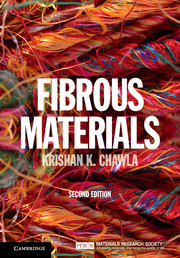Book contents
- Frontmatter
- Dedication
- Contents
- Preface to the Second Edition
- Preface to the First Edition
- Acknowledgments
- 1 Introduction
- 2 Fibers and fibrous products
- 3 Natural polymeric fibers
- 4 Synthetic polymeric fibers
- 5 Electrospun fibers
- 6 Metallic fibers
- 7 Ceramic fibers
- 8 Glass fibers
- 9 Carbon fibers
- 10 Experimental determination of fiber properties
- 11 Statistical treatment of fiber strength
- Appendix: Some important units and conversion factors
- Indexes
- Plate section
- References
9 - Carbon fibers
Published online by Cambridge University Press: 05 June 2016
- Frontmatter
- Dedication
- Contents
- Preface to the Second Edition
- Preface to the First Edition
- Acknowledgments
- 1 Introduction
- 2 Fibers and fibrous products
- 3 Natural polymeric fibers
- 4 Synthetic polymeric fibers
- 5 Electrospun fibers
- 6 Metallic fibers
- 7 Ceramic fibers
- 8 Glass fibers
- 9 Carbon fibers
- 10 Experimental determination of fiber properties
- 11 Statistical treatment of fiber strength
- Appendix: Some important units and conversion factors
- Indexes
- Plate section
- References
Summary
Carbon fibers have become established engineering materials. In view of their commercial importance, we devote a separate chapter to them. Carbon is a very versatile element. It is very light, with a theoretical density of 2.27 g cm−3. It can exist in a variety of forms, glassy or amorphous carbon, graphite, and diamond. Carbon in all these forms can be found in nature. Carbon in the graphitic form has a hexagonal structure and is highly anisotropic. The diamond form of carbon has a covalent structure and is an extremely hard material. The latest additions to different forms of carbon are Buckminster Fullerene, or Buckyball, with a molecular composition such as C60 or C70, and carbon nanotubes. Carbon nanotubes (CNTs) are long, thin cylinders of carbon atoms arranged in a graphitic lattice structure. They include single-walled and multi-walled carbon nanotubes. In this chapter, we follow the same sequence as in previous chapters: processing, structure, properties, and applications of carbon fibers. However, in order to understand these aspects of carbon fiber, it is helpful to review the basic structure and properties of graphite.
Structure and properties of graphite
Carbon fiber is a generic name representing a family of fibers. Over the years, it has become one of the most important reinforcement fibers in many different types of composite, especially in polymer matrix composites. It is an unfortunate fact that the terms carbon and graphite are used interchangeably in commercial practice as well as in some scientific literature. Rigorously speaking, graphite fiber is a form of carbon fiber that is obtained when we heat the carbon fiber to a temperature greater than 2400 °C. This process, called graphitization, results in a highly oriented, layered crystallographic structure, which, in turn, leads to significantly different chemical and physical properties from non-graphitic forms of carbon (see Section 9.2). The atomic arrangement of carbon atoms in the hexagonal structure of graphite is shown in Fig 9.1. The c-axis is perpendicular to the basal plane. A graphite single crystal will thus have hexagonal symmetry and its elastic properties will be transversely isotropic in the layer plane. Such crystal symmetry requires five independent elastic constants.
- Type
- Chapter
- Information
- Fibrous Materials , pp. 230 - 253Publisher: Cambridge University PressPrint publication year: 2016



